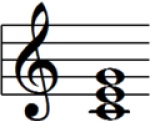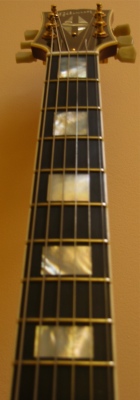
Music Theory 101
In one of my guitar classes, I had a student mentioned that she never thought she’d have to learn algebra to learn music. Algebra you ask? No .. we weren’t learning algebra. We may have been applying a little geometry to our musical education. We definitely were learning how to count (at least from one to twelve). We counted backwards and forwards. Maybe we added or subtracted notes. Yet, algebra is not something that we were using.
You see, there is a certain amount of math involved in music theory. A student of the banjo, guitar and mandolin must understand numbers to truly have an understanding of the fingerboard. Not all musicians understand music theory and yet, they are great players. However, the student who manages to understand the numerical relationships of notes, will have an easier time creating and playing melody lines and lead riffs.

Every Fingerboard Has Numerical Relationships
When comparing the banjo, guitar and mandolin, you will find certain numerical similarities, as well as some differences. The guitar, for instance, is tuned to fourths. This means that the note adjacent to another note you play on the next string is the forth note of the root note’s scale. Confused? Well, it is simpler than it sounds. The mandolin is tuned to fifths. The banjo? It is a little more complex regarding scale structure. I do not mean to confuse you further but on the banjo and in one instance, the guitar, the pattern of notes shift. It will be the shifts that alter a simple box relationship and make playing a scale a little more difficult.
Geometry & Music?
What about Geometry? Boxes, circles, angles and rectangles also exist on the banjo, guitar and mandolin. If you study the fingerboard of each of these instruments, you will discover relationships between many of the notes. It is these geometrical relationships that open up the fingerboard for a student.
So when you go to see your music instructor, if they do not know the relationships of the notes on the fingerboard, then they probably can’t help to clearly explain the instrument to you. A good instructor will not only know how to play the instrument but will be able to provide a fingerboard map to a student, which will guide you towards better lead play.

I must be learning something in my lessons because I’ve actually understood what you just wrote! I must have a good instructor! 🙂
Very interesting, i never thought the guitar fretboard was so mathematical until very recently. 4ths, boxes, and pentatonics. I’m sure there’s more. Thanks Fretmentor!
I have never thought of myself as mathematically oriented, but I am learning a lot about math now that I m learning the guitar. I’ve also learned that it is laid out well so that, theoretically, different combinations of chords and sounds are possible by moving up and down the finger board. Learning the theory really has helped with playing so I understand why I do something and not just memorize chords.
It’s important to know intervals everywhere on your fretboard and the intervals between the strings.
For example, the first two strings on the banjo, played together going from bottom to top (B -> D), create a minor third. So then you know if you make an open C chord, you’re fretting the first string at the 2nd fret and the 2nd string at the first fret, therein you know that interval is major third in the context of the C chord.
There are many “Osborne rolls” (MIMT) that go up and down the neck with the first two strings where you’ll also use this, and also in a melodic context as well.
Within the context of the G chord, however, playing all open string on the banjo, the B acts as a major third and the D as a perfect 5th within the G chord.
It has helped me to print out some blank fretboard paper and make my own fretboard “roadmaps” looking at intervals like this and how to transition between the forms.
On guitar, learning the five different “CAGED” forms really opened up the entire fretboard for me.
Thanks for the lesson Dave, I’m slowly putting music together. I’m sure the math will help.
Music is full of math. If you really want to drive yourself crazy look up Pythagorean comma. It’s a matter of reconciling the human mind with physics.
From Wikipedia, the free encyclopedia
In musical tuning, the Pythagorean comma (or ditonic comma), named after the ancient mathematician and philosopher Pythagoras, is the microtonal interval defined as the difference between a Pythagorean apotome and a Pythagorean limma, e.g.
The resulting pitch is 23.46 cents (approximately a quarter of a semitone).
[edit] Circle of fifths and enharmonic change
The Pythagorean comma can also be thought of as the discrepancy between twelve justly tuned perfect fifths (ratio 3:2) ( play (help·info)) and seven octaves (ratio 2:1), e.g.
Ascending by perfect fifths Note Fifth Frequency ratio Decimal ratio
C 0 1 : 1 1
G 1 3 : 2 1.5
D 2 9 : 4 2.25
A 3 27 : 8 3.375
E 4 81 : 16 5.0625
B 5 243 : 32 7.59375
F♯ 6 729 : 64 11.390625
C♯ 7 2187 : 128 17.0859375
G♯ 8 6561 : 256 25.62890625
D♯ 9 19683 : 512 38.443359375
A♯ 10 59049 : 1024 57.6650390625
E♯ 11 177147 : 2048 86.49755859375
B♯ (≈ C) 12 531441 : 4096 129.746337890625
Ascending by octaves Note Octave Frequency ratio
C 0 1 : 1
C 1 2 : 1
C 2 4 : 1
C 3 8 : 1
C 4 16 : 1
C 5 32 : 1
C 6 64 : 1
C 7 128 : 1
In the following table of musical scales in the circle of fifths, the Pythagorean comma is visible as the small interval between e.g. F♯ and G♭.
The 6♭ and the 6♯ scales* are not identical – even though they are on the piano keyboard – but the ♭ scales are one Pythagorean comma lower. Disregarding this difference leads to enharmonic change.
* The 7♭ and 5♯, respectively 5♭ and 7♯ scales differ in the same way by one Pythagorean comma. Scales with seven accidentals are seldom used, because the enharmonic scales with five accidentals are treated as equivalent.
This interval has serious implications for the various tuning schemes of the chromatic scale, because in Western music, 12 perfect fifths and seven octaves are treated as the same interval. Equal temperament, today the most common tuning system used in the West, accomplished this by flattening each fifth by a twelfth of a Pythagorean comma (approximately 2 cents), thus producing perfect octaves.
Another way to express this is that the harmonic fifth has a frequency (compared to the tonic) of 1.5 whereas the seventh semitone (based on 12 equal logarithmic divisions of an octave) is the seventh power of the twelfth root of 2 which is 1.4983… ie not quite the same (out by about 0.1%). Take this to the twelfth power (ie over 12 octaves) and you get the Pythagorean comma (about 1.4% difference).
Chinese mathematicians had been aware of the Pythagorean comma as early as 122 BC (its calculation is detailed in the Huainanzi), and circa 50 BC, Ching Fang discovered that if the cycle of perfect fifths were continued beyond 12 all the way to 53, the difference between this 53rd pitch and the starting pitch would be much smaller than the Pythagorean comma. This much smaller interval was later named Mercator’s comma (see: history of 53 equal temperament).
OK, I understand and agree with what Fretmentor wrote, and thanks to lessons I can apply it to the banjo and guitar. But after reading Stephanie and Brilind, I feel I’m educated beyond my intelligence.
Yes, Brilind is right. How much math is involved in music theory depends on how deep you want to go. If you delve deep enough, you’ll end up dealing with fractals and the non-rational numbers. Not necessarily of immediate practicality if you want to strum a few chords. But it will teach you respect for music… Music can be a window to the universe!
I was never good at math, but this math is way over my head. I will need lots of instructions to understand it. I finally lately learned how to use the circle of fifths.
Sparks